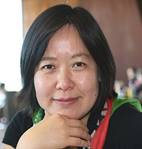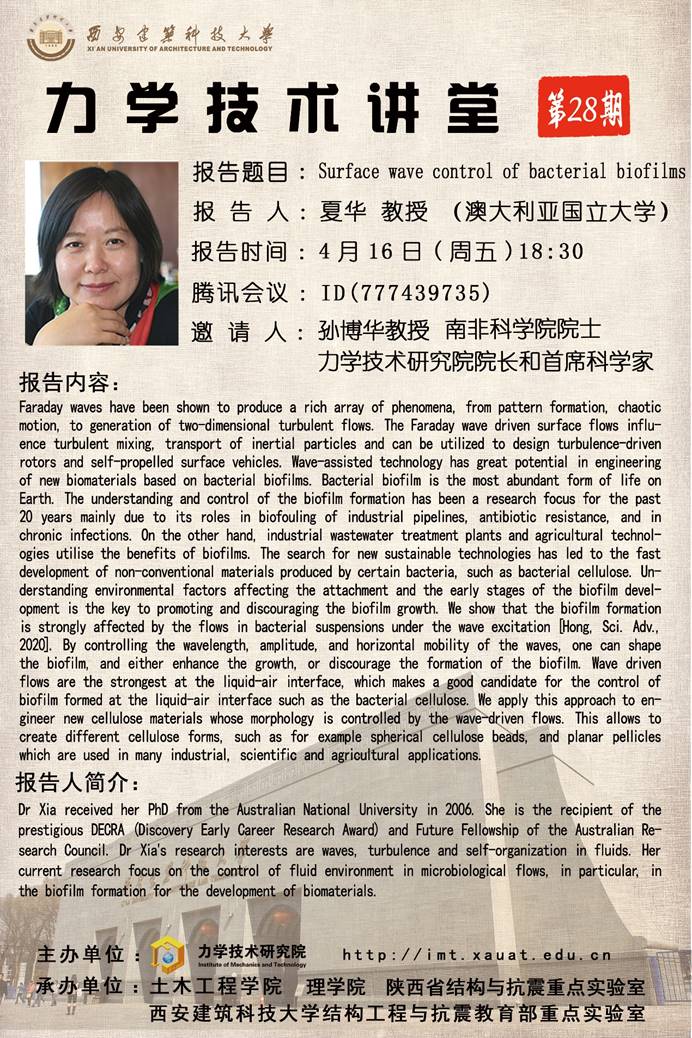报告人: 夏华 教授(澳大利亚国立大学)
报告题目:Surface wave control of bacterial biofilms
报告时间:2021年4月16日(周五)18:30
腾讯会议:ID(777439735)
邀 请 人: 孙博华教授 南非科学院院士、力学技术研究院院长和首席科学家
报告人简介:
 Dr Xia received her PhD from the Australian National University in 2006. She is the recipient of the prestigious DECRA (Discovery Early Career Research Award) and Future Fellowship of the Australian Research Council. Dr Xia's research interests are waves, turbulence and self-organization in fluids. Her current research focus on the control of fluid environment in microbiological flows, in particular, in the biofilm formation for the development of biomaterials.
Dr Xia received her PhD from the Australian National University in 2006. She is the recipient of the prestigious DECRA (Discovery Early Career Research Award) and Future Fellowship of the Australian Research Council. Dr Xia's research interests are waves, turbulence and self-organization in fluids. Her current research focus on the control of fluid environment in microbiological flows, in particular, in the biofilm formation for the development of biomaterials.
夏华博士2006年从澳大利亚国立大学毕业,从事湍流,表面波以及相关的输运等实验物理研究, 及其在微生物流体系统中的应用。获得澳大利亚研究基金会的初级研究基金和未来人才研究基金(为澳大利亚科学发展的未来而设立的基金)。在有高影响因子的杂志上发布了50多篇文章,其中包含4篇自然子刊 (Nature Physics and Nature Communications),2篇Science Advances, 2篇 PNAS (Proceedings of the National Academy of Sciences)和14篇物理通信(Physical Review Letters)。
报告摘要:
Faraday waves have been shown to produce a rich array of phenomena, from pattern formation, chaotic motion, to generation of two-dimensional turbulent flows. The Faraday wave driven surface flows influence turbulent mixing, transport of inertial particles and can be utilized to design turbulence-driven rotors and self-propelled surface vehicles. Wave-assisted technology has great potential in engineering of new biomaterials based on bacterial biofilms. Bacterial biofilm is the most abundant form of life on Earth. The understanding and control of the biofilm formation has been a research focus for the past 20 years mainly due to its roles in biofouling of industrial pipelines, antibiotic resistance, and in chronic infections. On the other hand, industrial wastewater treatment plants and agricultural technologies utilise the benefits of biofilms. The search for new sustainable technologies has led to the fast development of non-conventional materials produced by certain bacteria, such as bacterial cellulose. Understanding environmental factors affecting the attachment and the early stages of the biofilm development is the key to promoting and discouraging the biofilm growth. We show that the biofilm formation is strongly affected by the flows in bacterial suspensions under the wave excitation [Hong, Sci. Adv., 2020]. By controlling the wavelength, amplitude, and horizontal mobility of the waves, one can shape the biofilm, and either enhance the growth, or discourage the formation of the biofilm. Wave driven flows are the strongest at the liquid-air interface, which makes a good candidate for the control of biofilm formed at the liquid-air interface such as the bacterial cellulose. We apply this approach to engineer new cellulose materials whose morphology is controlled by the wave-driven flows. This allows to create different cellulose forms, such as for example spherical cellulose beads, and planar pellicles which are used in many industrial, scientific and agricultural applications.

欢迎广大师生聆听报告,参与交流!